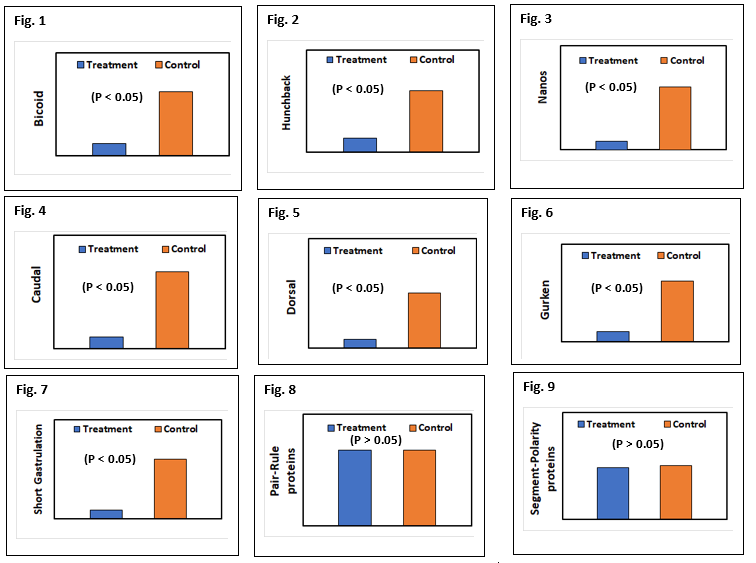After graduating from UNC Charlotte with the BS in Biology, you get a job with an agro-chemical company and are assigned to a lab that is exploring the use of a newly synthesized compound that may be a possible insecticide. The compound is thought to control insect populations by disrupting the genes that control embryonic development. Your lab conducts an experiment to investigate the influence of the compound on developmental genes by measuring the levels of the proteins the genes code for. You measure protein levels in two groups of insect eggs: the Treatment Group, which is exposed to the compound, and the Control Group, which is exposed to a compound that is known to have no negative effects on gene activity. Your results are shown below. In all graphs, the Control group exhibits normal levels of proteins and gene expression. (Remeber: P > 0.05 means the observed differences are not significant; P < 0.05 means the differences are significant and biologically meaningful). True and False: 7. The compound will prevent fertilization of the egg by disrupting the genes that regulate the formation of the micropyle in the chorion. 8. The compound does not inhibit the formation of segments along the dorso-ventral axis, but will prevent the formation of wings in dorsal regions of the thoracic segments. 9. The compound does not inhibit the formation of segments along the anterior-posterior axis, but will prevent the formation of ommatidia in the head segments. 10. The compound disrupts the expression of zygotic genes, but has no effect on the expression of maternal genes.
Gene Interactions
When the expression of a single trait is influenced by two or more different non-allelic genes, it is termed as genetic interaction. According to Mendel's law of inheritance, each gene functions in its own way and does not depend on the function of another gene, i.e., a single gene controls each of seven characteristics considered, but the complex contribution of many different genes determine many traits of an organism.
Gene Expression
Gene expression is a process by which the instructions present in deoxyribonucleic acid (DNA) are converted into useful molecules such as proteins, and functional messenger ribonucleic (mRNA) molecules in the case of non-protein-coding genes.
After graduating from UNC Charlotte with the BS in Biology, you get a job with an agro-chemical company and are assigned to a lab that is exploring the use of a newly synthesized compound that may be a possible insecticide. The compound is thought to control insect populations by disrupting the genes that control embryonic development. Your lab conducts an experiment to investigate the influence of the compound on developmental genes by measuring the levels of the proteins the genes code for. You measure protein levels in two groups of insect eggs: the Treatment Group, which is exposed to the compound, and the Control Group, which is exposed to a compound that is known to have no negative effects on gene activity. Your results are shown below. In all graphs, the Control group exhibits normal levels of proteins and gene expression. (Remeber: P > 0.05 means the observed differences are not significant; P < 0.05 means the differences are significant and biologically meaningful).
True and False:
7. The compound will prevent fertilization of the egg by disrupting the genes that regulate the formation of the micropyle in the chorion.
8. The compound does not inhibit the formation of segments along the dorso-ventral axis, but will prevent the formation of wings in dorsal regions of the thoracic segments.
9. The compound does not inhibit the formation of segments along the anterior-posterior axis, but will prevent the formation of ommatidia in the head segments.
10. The compound disrupts the expression of zygotic genes, but has no effect on the expression of maternal genes.

Step by step
Solved in 2 steps









